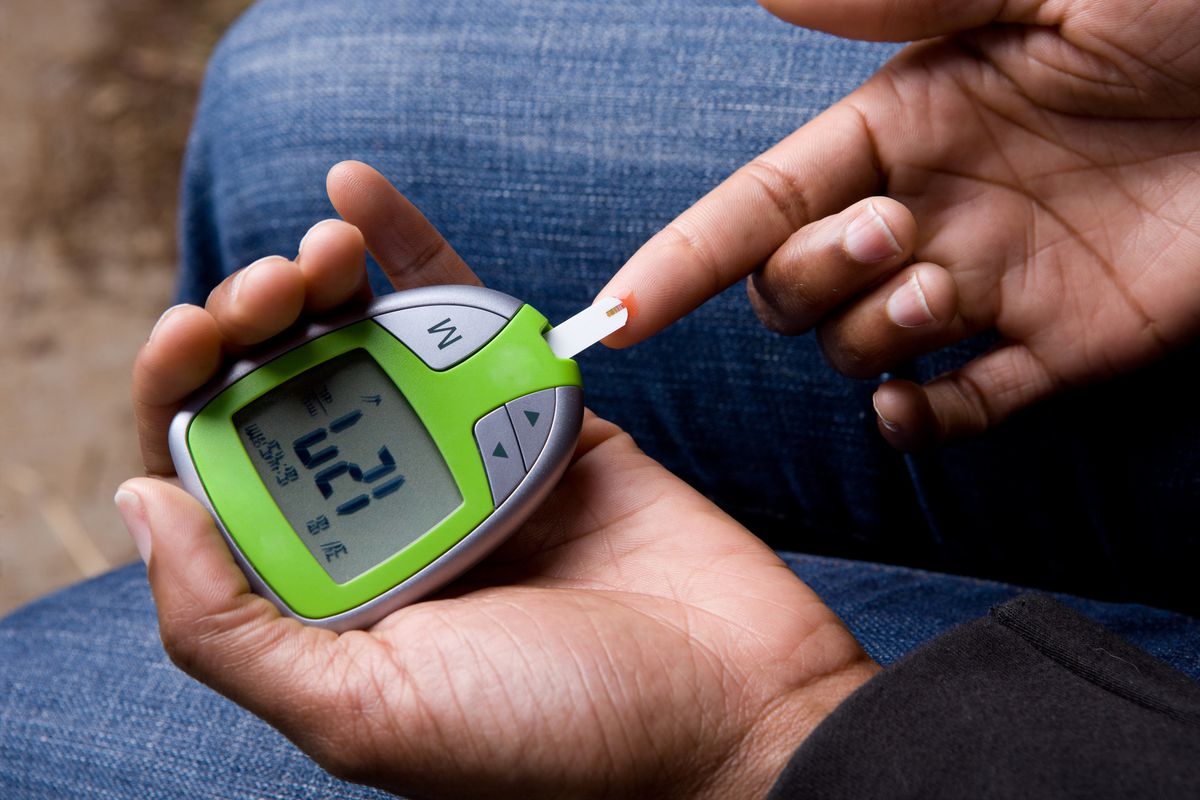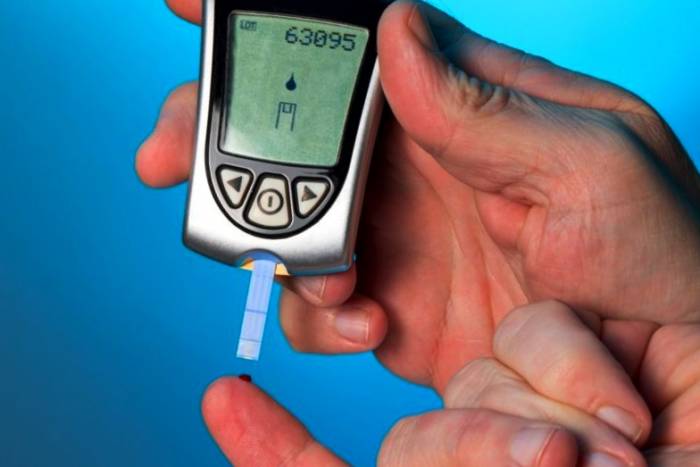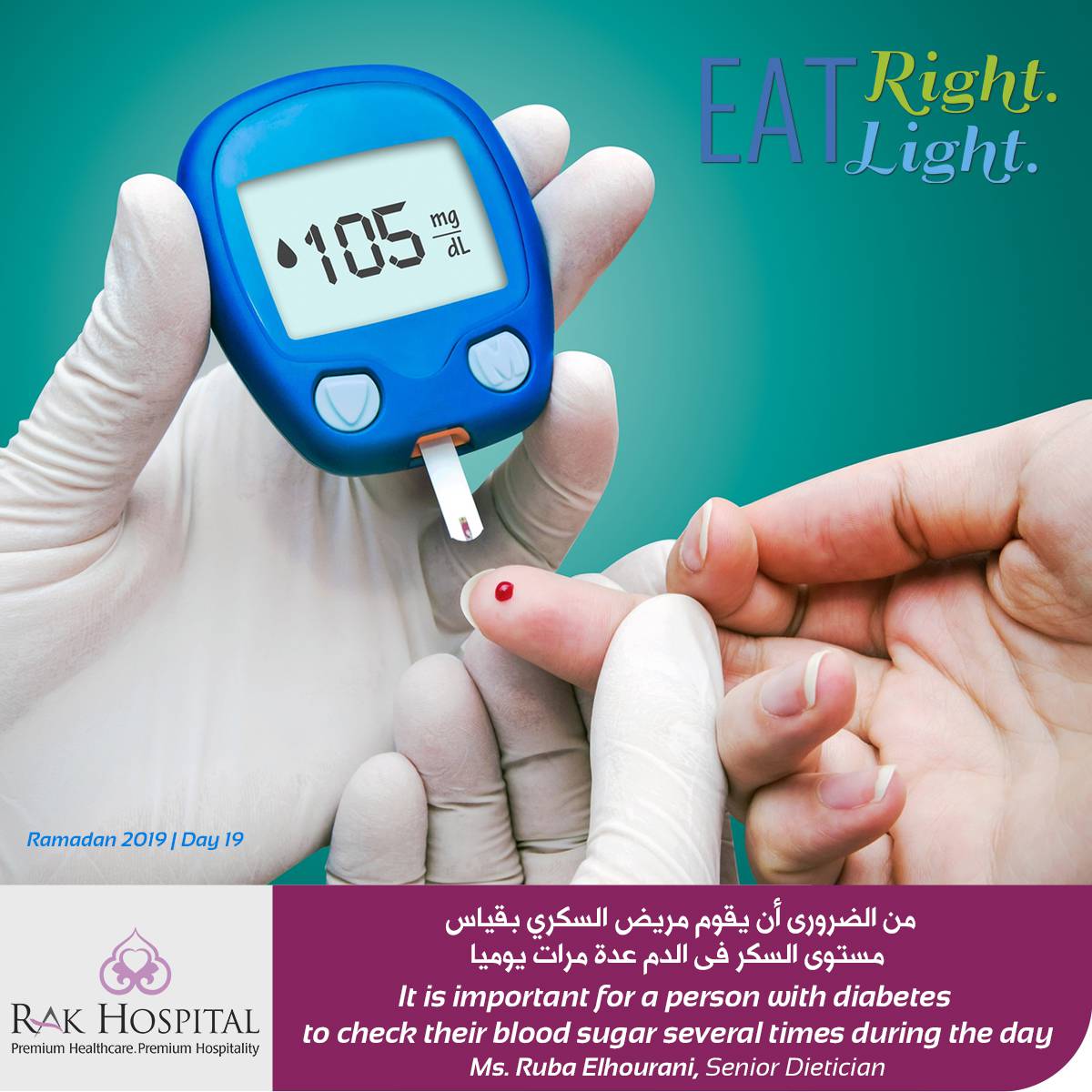Blood Sugar Testing At Home
A person can test their blood sugar levels at home.
In most cases, doctors ask people to measure fasting blood sugar immediately upon waking and before they have anything to eat or drink. It may also be appropriate to test blood sugar before eating or 2 hours after a meal, which is when blood sugar returns to normal levels.
The right time to test depends on treatment goals and other factors. For example, most people with diabetes do not need to test between meals unless they are using a diabetes drug that can lower blood sugar. Other people may test between meals if they feel their sugar levels may be low.
Since people with type 1 diabetes do not make any insulin, they need to test their blood sugar levels several times a day so they can adjust their insulin doses.
A person will test blood sugar levels by:
- preparing the testing strip and glucose monitor to be ready for the blood sample
- using an alcohol swab to clean the testing area, which is usually the side of a fingertip
- lancing the testing area and bracing against a firm surface to help resist the impulse to pull away
- squeezing the testing area around the wound to maximize blood flow
- squeezing a drop of blood onto the test strip
- putting the strip into the monitor
- recording the time, blood sugar reading, and recent food intake in a log
Blood Sugar Monitoring: When To Check And Why
Managing diabetes is one part investigation and two parts action. Unlike some other diseases that rely primarily on professional medical treatment, diabetes treatment requires active participation by the person who has it. Monitoring your blood sugar level on a regular basis and analyzing the results is believed by many to be a crucial part of the treatment equation.
When someone is first diagnosedwith diabetes, he is usually given a blood sugar meter and told how and when to use it, as well as what numbers to shoot for. However, the advice a person receives on when to monitor and what the results should be generally depend on his type of diabetes, age and state of overall health. It can also depend on a health-care providers philosophy of care and which set of diabetes care guidelines he follows. At least three major health organizations have published slightly different recommendations regarding goals for blood sugar levels.
There is some common ground when it comes to blood sugar monitoring practices. For example, most people take a fasting reading before breakfast every morning. Some people also monitor before lunch, dinner and bedtime some monitor after each meal and some monitor both before and after all meals. However, when monitoring after meals, some people do it two hours after the first bite of the meal, while others prefer to check one hour after the start of a meal.
What You Need To Know About Glucose Meter Accuracy
Here are some things that can affect readings:
User error. Suspicious of the results? Read and follow the user guide instructions that come with your meter. Store your meter and strips away from sunlight and temperature extremes. Check the viability of each new bottle of test strips by running a check using glucose control solution .
Laboratory versus at-home results. Meters intended for self-monitoring by people with diabetes are allowed to vary by as much as plus or minus 10 percent from the results laboratory equipment would give.
Location of the blood. Blood glucose levels differ within the body. Rapid changes from dosing insulin or eating show up first in blood obtained from the fingertips.
Also Check: Metformin 500 Mg Dosage
How Can I Treat High Blood Sugar
Talk to your doctor about how to keep your blood sugar levels within your target range. Your doctor may suggest the following:
- Be more active. Regular exercise can help keep your blood sugar levels on track. Important: dont exercise if ketones are present in your urine. This can make your blood sugar go even higher.
- Take medicine as instructed. If your blood sugar is often high, your doctor may change how much medicine you take or when you take it.
- Follow your diabetes meal plan. Ask your doctor or dietitian for help if youre having trouble sticking to it.
- Check your blood sugar as directed by your doctor. Check more often if youre sick or if youre concerned about high or low blood sugar.
- Talk to your doctor about adjusting how much insulin you take and what types of insulin to use.
By Step Instructions To Test Your Glucose

Glucose testing requires the utilization of a little electronic gadget called a glucometer. The meter peruses the measure of sugar in a little example of blood, as a rule from at the tip of your finger, that you place on a dispensable test strip. Your specialist or diabetes instructor can suggest a fitting gadget for you.
Your specialist or diabetes instructor can likewise enable you to figure out how to utilize a meter.
Adhere to the guidelines that accompany your glucose meter. As a rule, heres how the procedure works:
- Wash and dry your hands well.
- Supplement a test strip into your meter.
- Prick the side of at the tip of your finger with the needle furnished with your test pack.
- Tenderly crush or back rub your finger until a drop of blood pops.
- Contact and hold the edge of the test strip to the drop of blood.
The meter will show your blood glucose level on a screen following a couple of moments.
In the event that your meter can test blood taken from a substitute site, for example, the lower arm or palm, its imperative to comprehend that these readings may not be as exact as readings from the fingertips, particularly after a feast or amid exercise when glucose levels change all the more as often as possible.
You May Like: Diabetic Rash On Stomach
How Do I Check My Blood Glucose
Picture 1: Poke the side of the finger with the lancet
How Can I Check My Blood Sugar
Use a blood sugar meter or a continuous glucose monitor to check your blood sugar. A blood sugar meter measures the amount of sugar in a small sample of blood, usually from your fingertip. A CGM uses a sensor inserted under the skin to measure your blood sugar every few minutes. If you use a CGM, youll still need to test daily with a blood sugar meter to make sure your CGM readings are accurate.
Recommended Reading: How Long Does It Take To Lower Blood Sugar Without Medication
When Should I Check My Blood Sugar Levels
The number of times you should test your blood sugar levels each day and when will depend on lots of different things. It might even change from day to day. In general, most people with diabetes test their blood sugar levels before breakfast, before lunch, before dinner, and again at bedtime.
You may need to check blood sugar levels more often when you’re sick or when changes have been made to your medication doses or schedule. You also may need to check more often if you suddenly become more active, like after you join a sports team at school.
People who use an insulin pump or who follow a plan to control blood sugar levels very closely also need to check their blood sugar levels more often. Your diabetes health care team will help you decide how often and when you should check.
Sometimes, blood sugar levels must be checked in the middle of the night for instance, by people who are having problems with hypoglycemia symptoms during the night. And those who have just been diagnosed with diabetes may need more frequent blood sugar level tests to get a feel for how certain doses of insulin or other diabetes medicines affect their blood sugar levels.
Page 1
How Do I Take Care Of My Blood Glucose Meter
- Set the date and time when you get a new meter.
- Make sure the date and time are right each time you use your meter.
- Use the control solution as needed. This will let you know the meter and test strips are working right. Use it:
- When you get a new meter.
- When you get new test strips.
- When you think that the meter is not giving you the right blood glucose number.
Don’t Miss: 400 Glucose Level
Fasting Blood Glucose Level Test Preparation
What should you do if your doctor orders a fasting blood sugar test? The preparation is the same as when you take a fasting test for cholesterol. First, be sure to find out if you need to schedule an appointment for your test . Ask your doctor what time is best to take it.
Then:
- Schedule your test if necessary
- Ask your doctor if you need to change any of the medications you take on the morning of the test
- If you normally drink coffee or have caffeine, ask your doctor if that is okay. It may not be, since it affects blood sugar levels
- Fast for at least 8 hours before your test. Usually, an overnight fast is most convenient
- You can drink water
What Is Normal Blood Glucose
There is no one blood glucose level that defines a person as normal. The table of blood glucose levels below gives the appropriate values at different times and in different states, according to the American Diabetes Association. For example, insulin-dependent diabetics often use an upper limit of 7 mmol/L or 140 mg/dL, while non-insulin-dependent diabetics may aim for less than 6 mmol/L or 108 mg/DL.
The blood glucose levels range between less than 100-180 mg/dL for adults from 20 years or older. Depending on your age this may vary.
- Fasting: Less than 5.6 mmol/L or 100 mg/DL
- Before meal: 3.9-7.2 mmol/L or 70-130 mg/DL
- 1-2 hours after eating: Less than 10 mmol/L or 180 mg/DL
- Bedtime: 5.6-7.8 mmol/L or 100-140 mg/DL
Be aware that the above numbers might be different for everyone depending on your doctor’s recommendations.
You May Like: Does Metformin Cause Indigestion
Consider Testing At Night
Bedtime checks are recommended for:
People who take multiple daily injections.
People who use an insulin pump.
Checking before bed may be recommended if you take basal insulin, such as Levimir or Lantus, once a day at bedtime or split your dose of long-acting insulin into two injections.
What you should know about middle-of-the-night checks:
People who use insulin may be advised to do checks in the middle of the night to reveal hypoglycemia during the night. Talk to your provider about nighttime testing options for you.
How Do I Measure My Blood Sugar Level

Follow your doctors advice and the instructions that come with the BGM or CGM. Different meters work differently, so be sure to check with your doctor for advice specifically for you. With a BGM, youll usually follow the steps below:
- Wash your hands and dry them well before doing the test.
- Use an alcohol pad to clean the area that youre going to prick. For most glucose meters, you will prick your fingertip. However, with some meters, you can also use your forearm, thigh, or the fleshy part of your hand. Ask your doctor what area you should use with your meter.
- Prick yourself with a sterile lancet to get a drop of blood.
- Place the drop of blood on the test strip.
- Follow the instructions for inserting the test strip into your glucose meter.
- The meter will give you a number for your blood sugar level.
If you have a CGM, youll follow the insertion directions that come with the monitor. Once its warmed up, the transmitter wirelessly sends the data to your computer or smartphone.
You May Like: Blood Sugar Over 300
Why Test Blood Sugar Levels
If you take certain medication, like insulin or sulphonylureas, checking your blood sugars is a vital part of living with diabetes. It can help you work out when you need to take more medication, when you need to eat something or for when you want to get up and move around more.
Routine checks can help you know when you might be starting to go too low or too high . Its a way of getting to know your body and how it works. It can help you and your healthcare team spot patterns too. Do you write your results down? You might find that helpful.
But importantly, it will help you stay healthy and prevent serious diabetes complications now and in the future. By complications, we mean serious problems in places like your feet and your eyes. This happens because too much sugar in the blood damages your blood vessels, making it harder for blood to flow around your body. This can lead to very serious problems like sight loss and needing an amputation.
The higher your blood sugar levels are and the longer theyre high for, the more at risk you are.
The Big Picture: Checking Your Blood Sugar
Blood sugar monitoring is the primary tool you have to find out if your blood glucose levels are within your target range. This tells you your blood glucose level at any one time.
Its important for blood sugar levels to stay in a healthy range. If glucose levels get too low, we can lose the ability to think and function normally. If they get too high and stay high, it can cause damage or complications to the body over the course of many years.
The logging of your results is vital. When you bring your log to your healthcare provider, youll have a good picture of your body’s response to your diabetes care plan. To help keep track of your levels, we have a glucose log. We also have a blood glucose log available for purchase that is smaller so you can carry it with you.
You May Like: Fasting And Diabetes Dangers
Imagine A Scenario In Which You Have A Constant Glucose Screen Cgm:
Individuals treated with insulin, especially those with sort one diabetes, may likewise utilize a CGM. These gadgets measure your glucose at regular intervals utilizing a sensor embedded under the skin.
A few gadgets demonstrate your glucose perusing consistently on a beneficiary, and an alert will go off if your glucose is going up or going down too rapidly. Others necessitate that you check your glucose by running the collector over the sensor occasionally.
The vast majority of these gadgets still require finger-stick checks to adjust the machine. Check your gadgets client manual for learning on the off chance that you have to check, and how regularly you have to do as such.
Why Checking Your Blood Sugar Is Crucial
Monitoring your blood sugar helps your doctor determine if your treatment plan is working and if your medication needs adjusting. Blood sugar thats too high, referred to as hyperglycemia, or too low, known as hypoglycemia can cause health problems such as dizziness, confusion, blurred vision and even coma. The good news: A patient with well-controlled type 2 diabetes whos treated with metformin may only check their glucose a few times a week or month, says Dr. Kohlenberg.
You May Like: How Many Carbs Should A Diabetic Eat In A Day
/8the Right Time To Test Your Blood Sugar And The Correct Way To Do It
According to the International Diabetes Federation, 42.5 crore people are dealing with diabetes globally. The number is expected to increase to 62.9 crores by 2045.
The data is shocking and alarming because not just the elderly, even kids as young as 6 months old are getting diagnosed with the disease.
How Often Should I Test My Blood Sugar Level
Your family doctor will recommend how often you should test. Testing times are based on the kind of medicine you take and on how well your blood sugar levels are controlled. Youll probably need to check your blood sugar more often at first. Youll also check it more often when you feel sick or stressed, when you change your medicine, or if youre pregnant.
You May Like: Metformin Heart Rate
What Causes Low Blood Sugar
Low blood sugar has many causes, including missing a meal, taking too much insulin, taking other diabetes medicines, exercising more than normal, and drinking alcohol. Blood sugar below 70 mg/dL is considered low.
Signs of low blood sugar are different for everyone. Common symptoms include:
- Shaking.
- Dizziness.
- Hunger.
Know what your individual symptoms are so you can catch low blood sugar early and treat it. If you think you may have low blood sugar, check it even if you dont have symptoms. Low blood sugar can be dangerous and should be treated as soon as possible.
Make A Note Of Your Readings

It may sound obvious, but you must record your readings. Note them down in a diary, a notebook or in your phone calendar. Some meters have software that lets you do this. You could try a diabetes app too.
You and your healthcare team can then look back over your results to see if you need to adjust your treatment.
You May Like: Side Effects Of Glucophage

